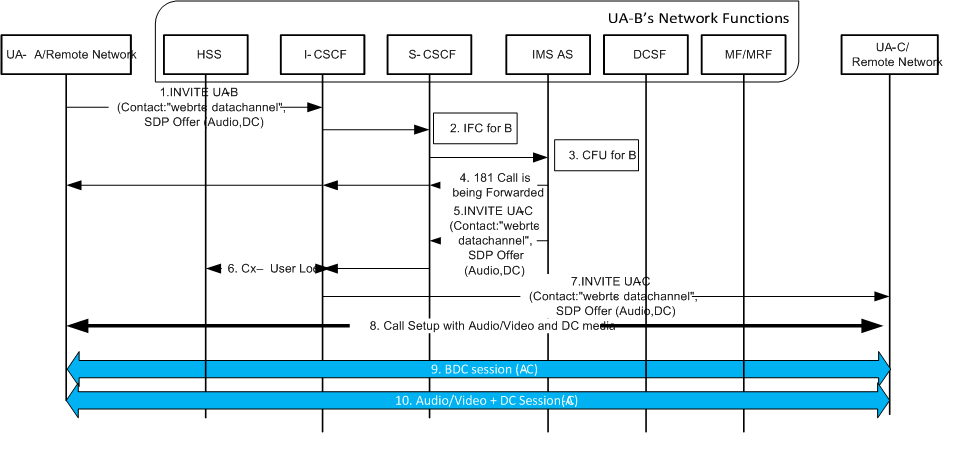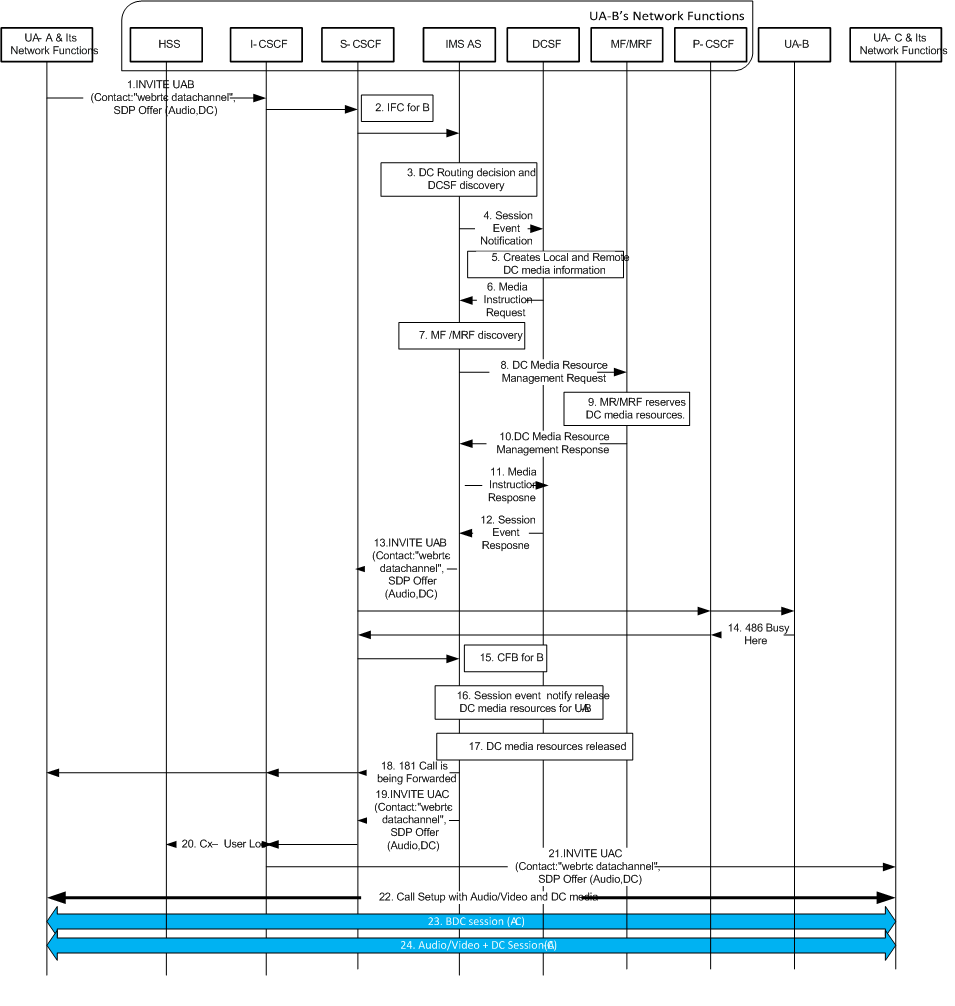Content for TS 24.186 Word version: 18.0.0
A Signalling flows
A.1 Interaction with supplementary services
A.1.1 Communication Diversion
A.1.1.1 Communication Forwarding unconditional
A.1.1.2 Communication Forwarding on Busy
...
...
A Signalling flows p. 30
This annex provides the signalling flows related to clause 10.
A.1 Interaction with supplementary services p. 30
Below sections depict signalling flow diagram for IMS data channel service interaction with existing MMTel supplementary services.
A.1.1 Communication Diversion p. 30
A.1.1.1 Communication Forwarding unconditional p. 30
Figure A.1.1.1-1 shows an example signalling flow for a successful communication forwarding unconditional based on an AS providing the forwarding and initial communication setup request consist of DC media session setup request along with other MMTel media session setup request.

The description of the steps mentioned in the Figure A.1.1.1-1 is in accordance with the TS 24.604 with the additions defined in the present document:
-
in step 1), user A(UA-A) sends initial INVITE request towards the user B(UA-B), which contains:
- the media feature tag defined in RFC 5688 for supported streaming media type with +sip.app-subtype="webrtc-datachannel" as specified in TS 26.114 in the Contact header field;
- optionally the Accept-Contact header field containing the "sip.app-subtype" media feature tag defined in RFC 5688 with a value of "webrtc-datachannel" as specified in TS 26.114; and
- the SDP offer containing the media descriptions for the MMTel media according TS 24.173 and a data channel media description for the bootstrap data channel in accordance with TS 26.114;
- in step 3), the IMS AS serving the user B(UA-B) receives SIP INVITE request with DC media. CFU service condition is satisfied based on the diverting user B(UA-B) subscription data. Depending on the diverting user B (UA-B) IMS data channel subscription, the IMS AS of the diverting user does not send session event notification to the DCSF for data channel setup. Procedures for CFU are executed;
- in step 5) the IMS AS sends SIP INVITE request with data channel media towards the diverted-to-user C(UA-C);
- in step 7) the communication is routed towards the diverted-to-user C(UA-C) along with data channel media;
- in step 9) bootstrap data channel is established for the originating user A(UA-A)/network and the diverted-to-user C(UA-C)/network; and
- in step 10) application data channel is established along with other MMTel media.
A.1.1.2 Communication Forwarding on Busy p. 31
Figure A.1.1.2-1 shows an example signalling flow for a successful communication forwarding on busy based on an AS providing the forwarding and initial communication setup request consist of DC media session setup request along with other MMTel media session setup request.

The description of the steps mentioned in the Figure A.1.1.2-1 is in accordance with the TS 24.604 with the additions defined in the present document:
- in step 1) user A(UA-A) sends initial INVITE request towards the user B(UA-B) in accordance with clause A.1.1.1 step 1);
- in step 3) to step 12) the IMS AS serving the user B(UA-B) receives SIP INVITE request with DC media. Depending on the user B(UA-B) IMS data channel subscription, the IMS AS of the user B(UA-B) triggers the reservation of resources for data channel setup in accordance with clause 9.3.3.2.1 and clause AC.7.1 of TS 23.228;
- in step 13) the initial INVITE request is sent to the user B(UA-B) along with data channel media due to normal communication procedures;
- in step 15) to step 17) on reception of the 486 (Busy Here) response for the initial INVITE request, in the IMS AS, CFB service condition is satisfied based on the diverting user B(UA-B) subscription data. Procedures for CFB are executed. The IMS AS notifies session reject event to the DCSF and as per media instruction request from the DCSF, the IMS AS sends media resource management request to the MRF to release the allocated data channel media resources for this SIP Session. The IMS AS notifies the DCSF about the DC media release as part of the media instruction response;
- in step 19) the IMS AS sends SIP INVITE request with data channel media towards the diverted-to-user C(UA-C);
- in step 21) the communication is routed towards the diverted-to-user C(UA-C) along with data channel media;
- in step 23) bootstrap data channel is established between the originating user A(UA-A)/network and the diverted-to-user C(UA-C)/network; and
- in step 24) application data channel is established along with other MMTel media.